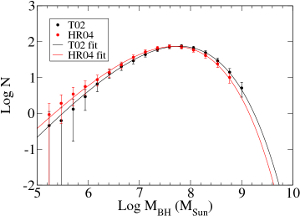|
|  |
There is little doubt now that the centres of massive galaxies are the habitat of black
holes with masses ranging from hundreds of thousands to billions of solar masses. Over
several years of investigation, astronomers have found that the masses of such supermassive
black holes are tightly related to the velocity dispersion of stars near the centre of
the galaxy. In addition, their masses are also related
to the total stellar mass of the galaxy,
when the host galaxy is an elliptical galaxy, or to the stellar mass of the central galaxy
bulge, when the host galaxy has a disc component.
These scaling relations prompted scientists
to develop theoretical models in which the formation of an elliptical galaxy or a bulge
is connected to the growth of the black hole. The rapid infall of baryonic matter
onto the gravitational potential of dark matter haloes
can in principle lead to the formation
of stellar structures such as elliptical galaxies and galaxy bulges, as well as central
supermassive black holes. In their early evolutionary stages, such black holes
are believed to release enormous amounts of energy,
which can regulate the formation of new stars in their hosts,
a mechanism known as feedback. Nevertheless, recent developments
indicate that elliptical galaxies and bulges might form through different ways.
Furthermore, there are also signs that different formation processes dominate in
different bulges. This leads us to question whether all black holes grow
in a similar fashion, or if their growth depends on how their host galaxies
form.
To tackle this problem, the new study uses results from detailed work on the structural
properties of a large sample of local massive
galaxies
( see Research Highlight July 2009), which
measures the stellar masses of elliptical galaxies
and bulges, and distinguishes, in a objective
fashion, pseudo-bulges and classical bulges, which are thought to form through different
dominant processes. Velocity dispersion measurements for the same sample
were obtained from the Sloan Digital Sky Survey (SDSS).
With these data at hand, it was found
that ellipticals and bulges follow offset relations between their stellar masses
and velocity dispersion. Since black hole mass correlates
with host stellar mass and velocity
dispersion, it follows that ellipticals and classical bulges cannot
follow single relations between black hole mass and host
mass and between black hole mass and
velocity dispersion. This in turn indicates that the way black holes
grow within the two kinds of stellar
systems is different. The new study also points out
that galaxies with pseudo-bulges
are displaced from the scaling relations defined by galaxies
with classical bulges, and this is usually caused by
the presence of a bar in the galaxy.
Bars lead to larger measured central velocity
dispersion, and this effect is important in galaxies hosting pseudo-bulges,
because the true velocity dispersion of the bulge is low in these systems. see Research Highlight July 2009), which
measures the stellar masses of elliptical galaxies
and bulges, and distinguishes, in a objective
fashion, pseudo-bulges and classical bulges, which are thought to form through different
dominant processes. Velocity dispersion measurements for the same sample
were obtained from the Sloan Digital Sky Survey (SDSS).
With these data at hand, it was found
that ellipticals and bulges follow offset relations between their stellar masses
and velocity dispersion. Since black hole mass correlates
with host stellar mass and velocity
dispersion, it follows that ellipticals and classical bulges cannot
follow single relations between black hole mass and host
mass and between black hole mass and
velocity dispersion. This in turn indicates that the way black holes
grow within the two kinds of stellar
systems is different. The new study also points out
that galaxies with pseudo-bulges
are displaced from the scaling relations defined by galaxies
with classical bulges, and this is usually caused by
the presence of a bar in the galaxy.
Bars lead to larger measured central velocity
dispersion, and this effect is important in galaxies hosting pseudo-bulges,
because the true velocity dispersion of the bulge is low in these systems.
The MPA scientists also carried out a detailed census of
the black holes present in the local Universe using the large sample
of galaxies available to them. It was found that 55 per cent of the mass in black holes
in the local Universe is in the centres of elliptical galaxies,
41 per cent in classical bulges and
4 per cent in pseudo-bulges.
Unfortunately, however, the results depend quite sensitively on whether
host mass or velocity dispersion is used to infer the black hole mass.
The next generation of very large ground-based telescopes
with adaptive optics will allow scientists to
measure the motions of the stars and gas in the central regions
of galaxies, and obtain precise black hole mass measurements
for thousands of nearby ellipticals and disc galaxies. Today we only have
a few dozen such measurements. This will revolutionise the field, as
we will no longer need to rely on indirect measures of black hole mass
as we did in this study. This will bring new understanding to how supermassive
black holes and their host galaxies have co-evolved across cosmic time.
Dimitri Gadotti and Guinevere Kauffmann
Publications
Dimitri Alexei Gadotti and Guinevere Kauffmann,
"The growth of supermassive black
holes in pseudo-bulges, classical bulges and elliptical galaxies",
2009, Monthly Notices of the Royal Astronomical Society, in press
 2009MNRAS.tmp.1121G 2009MNRAS.tmp.1121G
|




